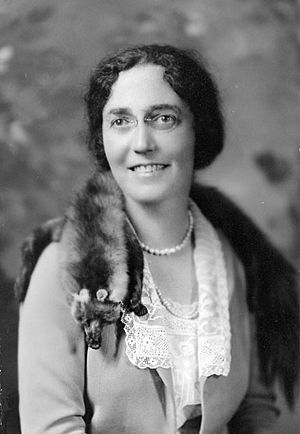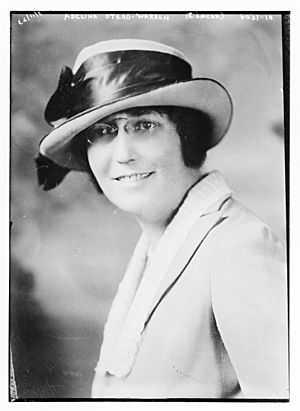Adelina Otero-Warren facts for kids
Quick facts for kids
Adelina Otero-Warren
|
|
|---|---|
 |
|
| Born |
María Adelina Isabel Emilia Otero
October 23, 1881 |
| Died | January 3, 1965 (aged 83) |
| Nationality | American |
| Alma mater | Maryville College of the Sacred Heart |
| Occupation | Educator, Republican Party Politician, Suffragist |
| Political party | Republican |
| Spouse(s) |
Rawson D. Warren
(m. 1908; div. 1910) |
María Adelina Isabel Emilia "Nina" Otero-Warren (born October 23, 1881 – died January 3, 1965) was an important American leader. She worked for women's right to vote, was an educator, and a politician. Otero-Warren helped her community through her work in education, government, and public health. She became one of New Mexico's first female government officials. She served as the Superintendent of Instruction for Santa Fe from 1917 to 1929. In 1922, she made history as the first Latina woman to run for the U.S. Congress. She was the Republican candidate for New Mexico.
Contents
Early Life and Education
Adelina Otero-Warren was born on October 23, 1881. Her birth name was María Adelina Isabel Emilia Otero. She was born at her family's large ranch, called "La Constancia," near Los Lunas, New Mexico. Her parents, Eloisa Luna Otero Bergere and Manuel B. Otero, belonged to a group of important Hispanic families in New Mexico, known as Hispanos. Her mother's family were among the first settlers in New Mexico, arriving in 1598. Her father's family also came from Spain in 1786.
Her father, Manuel, was well-educated. He studied at Georgetown University in Washington D.C. and at Heidelberg University in Germany. Her mother had studied at a Catholic school in New York. Adelina's family became wealthy and powerful through successful "sheep drives" during the California Gold Rush. This helped them gain political connections and own a lot of land. Adelina had two older brothers, Eduardo and Manuel, and nine half-siblings.
In 1883, when Adelina was two years old, her father died during an argument about his land. In 1886, her mother married Alfred Maurice Bergere, an Englishman. He was a businessman who had moved to New Mexico in 1880. This marriage helped connect important Anglo-American and Spanish families in New Mexico.
Adelina grew up in a traditional Spanish home in Los Lunas. She was surrounded by many relatives and other wealthy Hispanic families. Her family lived in the Luna Mansion, a large adobe-brick house. An Irish governess named Mary Elizabeth Doyle also helped raise Adelina.
Adelina's mother was very active in improving society and education. In the early 1900s, she became the director of Santa Fe’s Board of Education. She believed education was very important. She worked to make local schools better and cared for people who were poor or sick.
From 1892 to 1894, Otero-Warren went to a private Catholic boarding school in Saint Louis, Missouri. This school taught her that women could have careers as teachers and community leaders. Even when she was young, her family saw her as a natural leader. They said she "had the brains of the family." After returning from school, she taught her siblings what she had learned. She also asked her male relatives to teach her how to use firearms for self-protection.
In 1897, she moved to Santa Fe, New Mexico. This was when her father's cousin, Miguel Antonio Otero II, became the governor of New Mexico.
Early Adulthood and New Beginnings
In 1908, Adelina married Lieutenant Rawson D. Warren, a cavalry officer. He was stationed at Fort Wingate in New Mexico. Two years later, when she was 26, Otero-Warren divorced her husband. At that time, divorce was not widely accepted. To avoid social judgment, she told people she was a "widow" and that her husband had died. However, she kept his last name, Warren.
In 1912, she moved to New York City. She likely went there to care for her brother, Luna Bergere, who was a medical student. While in New York, she helped at Anne Morgan's settlement house. This organization helped working-class women. She organized arts and crafts programs there.
In 1914, Adelina's mother, Eloisa, passed away. Her mother left her Luna family lands to Adelina. This followed a tradition where Hispanic mothers passed their lands to their daughters. After her mother's death, Adelina returned from New York City to care for her nine half-siblings. She became like a mother to them. However, her sister Anita and their governess, Elizabeth Doyle, handled the daily care of the children.
Otero-Warren was friends with many artists and writers. These friends were important in the progressive movement of the 20th century. Some of them included Mary Austin, Witter Byner, Mamie Meadors, and Alice Henderson.
Political Career and Public Service
Working for Women's Right to Vote
Otero-Warren became good friends with Ella St. Clair Thompson. Ella led the Congressional Union for Women's Suffrage in New Mexico.
In 1914, Otero-Warren began working for women's right to vote in New Mexico. She joined the Congressional Union, which later became the National Woman's Party. She worked hard with women's groups and talked to lawmakers to gain support for suffrage. This helped her become a leader in the Congressional Union. The Union wanted to include Hispanic women in their efforts. They wanted to make sure New Mexico approved the Nineteenth Amendment, which would give women the right to vote.
Otero-Warren was perfect for this role. She was the first Mexican-American state leader of the Congressional Union in New Mexico. Her leadership brought support from both Spanish-speaking and English-speaking communities. She told the leader of the Union, Alice Paul, that she would always stand firm for their cause.
Otero-Warren also sought support for women's suffrage through her other roles. She chaired legislative committees for the Republican Party and the New Mexico Federation of Women's Clubs. She talked to New Mexico congressmen, urging them to vote for the Nineteenth Amendment. She was very influential because her uncle and other Hispanic relatives were elected leaders. Alice Paul said that Otero-Warren was key to New Mexico approving the Nineteenth Amendment. New Mexico gave women full voting rights when the federal amendment was approved in 1920.
Running for Congress
Otero-Warren believed she could do even more for Hispanos, especially in education, if she was in Congress. New Mexico had only one seat in the U.S. House of Representatives. This made the position very important and sought after. In 1922, she won the Republican Party nomination to run for the U.S. House of Representatives. She defeated the current representative, Nestor Montoya. With this victory, Otero-Warren became the first Latina woman to run for Congress.
If elected, she promised to help Hispano landowners get back their traditional land grants in New Mexico. She was proud of her Hispanic heritage. She spoke Spanish and worked to preserve Hispanic culture. Her campaign focused on improving education, health care, and welfare services. However, during her election, news of her divorce became public. There were also concerns about her views on teaching Spanish in schools and hiring Hispanic teachers. In the end, she lost the election to the Democrat John Morrow.
Leadership in Education and Public Health
1910s-1920s
From 1917 to 1929, Otero-Warren was the Santa Fe Superintendent of Instruction. She was one of New Mexico's first female government officials. In this job, she worked hard to improve education for Hispanos, Native Americans, and students in rural areas.
She made many important changes. She fixed old school buildings and increased teacher salaries. She made the school year longer, to nine months. She also created high school programs for counties and adult education classes. She changed the school curriculum to focus on bilingual and bicultural education. This new way of teaching for Hispano children included:
- English language lessons in class.
- Teachers who understood different cultures.
- Spanish lessons through art.
- No punishment for speaking Spanish at school.
- Parents and teachers working together to teach traditional crafts.
This "Americanization with kindness" approach was groundbreaking. At that time, many schools in the Southwest punished students for speaking Spanish. In 1927, a controversy arose about her also working as a sales representative for a textbook company. Although she was cleared of any wrongdoing, she decided not to run for re-election. Her half-sister, Anita Bergere, took over her position.
In 1919, the Governor of New Mexico, Octaviano A. Larrazolo, appointed her to the state Board of Health. She soon became the chair of this committee. She was chosen for this role because of her work with groups like the Red Cross.
After 1923, she briefly worked as an inspector for Indian schools in Santa Fe County. She argued against sending Native children to boarding schools far from their homes. She wanted better cooperation between families and schools. While she did try to help Native students adapt to American ways, she also wanted them to learn about their own culture, history, and traditions.
1930s-1940s
After her time as Superintendent, Otero-Warren continued to work on including different cultures and languages in public schools. She believed in teaching traditional crafts like weaving and furniture making, while also keeping local culture alive.
President Franklin D. Roosevelt appointed her as the state director for the federal Civilian Conservation Corps (CCC). In 1930, she became the Director of Literacy Education for the CCC. At this time, many people could not read well. She continued to fight for bilingual education. She believed that better reading skills would help people be better citizens.
In 1941, she worked with the Works Progress Administration (WPA) and the CCC on adult education. She was appointed Director of the Work Conference for Adult Teachers in Río Piedras, Puerto Rico. She found that there were not enough resources there. So, she created a plan to teach Spanish as the main language until 5th grade. English was taught as a foreign language. Her goal was to create a cultural bridge to improve people's lives. She also created a program at Borinquen Field. This program taught Spanish to American soldiers, sailors, and marines.
In the 1930s and 1940s, she also worked to protect old buildings in Santa Fe and Taos. During this time, she met many artists, writers, and thinkers in New Mexico. Throughout her life, she always promoted and celebrated Hispanic and Native cultures, arts, and languages.
Later Life and Lasting Impact
In the 1920s, Adelina Otero-Warren became very close friends with Mamie Meadors. Mamie moved to Santa Fe in 1918 for her health. She volunteered for Otero-Warren's campaign in 1922. Later, she became Otero-Warren's assistant for her work as an inspector of Indian schools. They lived in different homes on the same property and spent a lot of time together. They were known as "Los Dos," meaning "The Two."
By 1947, Otero-Warren started her own real estate business in Santa Fe called Los Dos Realty and Insurance Company, with Meadors. After Mamie Meadors died in 1951, Otero-Warren continued the business on her own. She focused on selling homes until she passed away at 83 years old. Even in her old age, she continued to help others financially.
Her impact continued after her death on January 3, 1965. On October 26, 1988, the Otero Elementary School was founded in Colorado. It stands as a tribute to Otero-Warren.
In 2021, the United States Mint announced that Otero-Warren would be one of the first women featured on the back of the quarter coin. This is part of the American Women quarters series. She will be the first Hispanic American to appear on U.S. currency.
See also
 In Spanish: Adelina Otero-Warren para niños
In Spanish: Adelina Otero-Warren para niños


